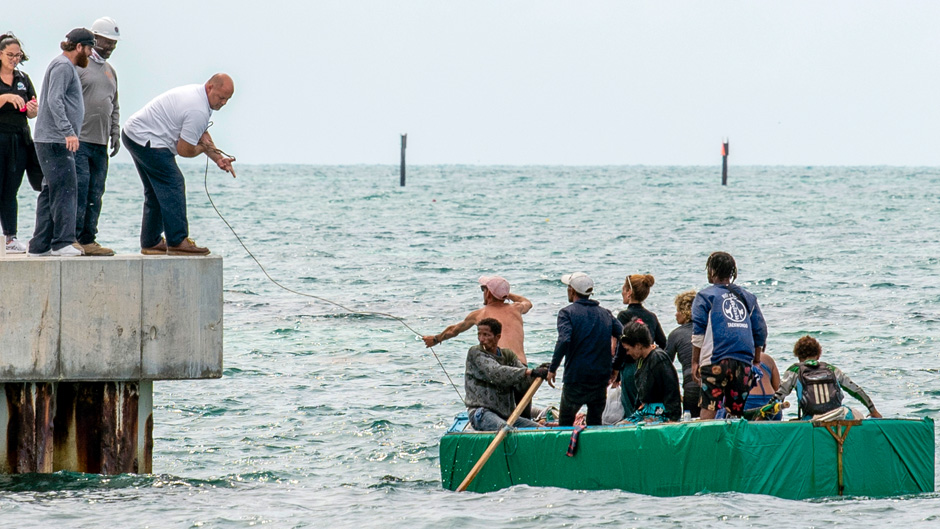A record number of migrants arrived at the southern borders of the United States during the past fiscal year, taxing immigration officials and creating havoc in towns along that stretch of the country. Florida also continues to see a rise in Cuban and Haitians arriving to its shores.
About 2.76 million people arrived at U.S. borders between Sept. 30, 2021, and Sept. 30, 2022, according to U.S. Customs and Border Protection data.
An increasing number of these migrants are coming from Cuba, Venezuela, Haiti, and Nicaragua. They are fleeing a host of maladies that include political repression, gang violence, and hunger that were made worse by the coronavirus pandemic, according to experts.
Two main factors are contributing to the flow, according to David Abraham, professor emeritus from the University of Miami School of Law and an expert on immigration law.
“Conditions continue to deteriorate in these particular countries, whether it is Haiti or Cuba, Venezuela, or Nicaragua.” he said. “There is also the perception—correct or otherwise—that after the end of the Trump government the Biden administration will in the long run be more receptive to those who manage to make it. It is worth the gamble.”
The huge gamble migrants take to brave the Florida Straits or cross the treacherous Darien gap in Central America to arrive to the U.S. is also fueled by the rise of technology, said Alejandro Portes, demographer, sociologist, and School of Law professor.
“Everyone has a cellphone nowadays, and they can access information about the standards of life in the advanced countries,” said Portes, who also has an appointment in the Department of Sociology. “They see that people in those countries seem to be doing well compared to many of their own countries. This has led to many young people envisioning their future lives in misery, and they cannot reconcile themselves to this fate.”
Another factor for the migration is the number of “imploded countries or failed states,” Portes pointed out. These include Cuba and Venezuela, where regimes cannot provide basic necessities—like food and medicine—for its citizens.
“Each and every Cuban who comes to the U.S. was received as a political refugee, when we know that was not true,” said Abraham. “They were overwhelmingly economic migrants in a way like Haitians and Mexicans or anyone else.”
However, Cubans are protected under the Cuban Adjustment Act, a 1966 law that allows any Cuban citizen who reaches U.S. borders to apply for residency after one year and a day in the country. Many Cubans who make it claim asylum and are released to relatives with a summons to appear in court at a future date.
By contrast, the majority of the Haitians intercepted by the U.S. Coast Guard are deported. “There is no Haitian adjustment act,” said Portes.
In the past months, U.S. Coast Guard authorities have been repatriating many Cuban rafters who were intercepted at sea. In early January, President Joe Biden announced a series of measures to try to stem the flow of people arriving.
The administration will now accept up to a total of 30,000 migrants per month from Nicaragua, Cuba, Haiti, and Venezuela under a humanitarian parole program geared toward those nationalities. Those who do not come to the U.S. under that program may be expelled to Mexico under Title 42, a law created during the coronavirus pandemic to address public health concerns.
Officials said they would return 30,000 migrants total per month from the aforementioned countries who circumvent the legal processes to Mexico.
Migrants who wish to come to the U.S. must apply from their home countries, or from another country where they are residing for safety, before traveling to the U.S. and must have a U.S. sponsor. If they are approved, they can travel by plane.
Of course, many migrants may still be able to circumvent the guidelines, according to Portes. He said that he does not believe the guidelines will be effective. Portes noted that the immigration crisis and open border will continue because of a major glitch in the U.S. asylum system that guarantees anyone reaching the country the right to claim asylum and to have their case heard before an immigration judge.
This creates a glut of migrants that is currently overwhelming the immigration system. Agencies lack facilities to house petitioners and also need more judges to review their cases, explained Portes.
“What do you do with all these people who are waiting for their cases to be heard?” asked Abraham. Many are being released on their own recognizance and given a future date to appear in court, he pointed out.
Both experts agree that an easy solution to the immigration crisis is not present.
“In principle it should be solvable,” said Portes. “But Congress has not acted to reform the system.”
In addition to revenue that is needed to add resources for faster expedition of applicants, it would take congressional action to change the “Kafkaesque asylum system,” said Portes. He added that once an immigrant is allowed access to life in the U.S., it would be rare for that person to return to their own country.

